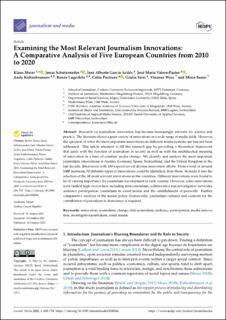Please use this identifier to cite or link to this item:
https://doi.org/10.21256/zhaw-25861Full metadata record
| DC Field | Value | Language |
|---|---|---|
| dc.contributor.author | Meier, Klaus | - |
| dc.contributor.author | Schützeneder, Jonas | - |
| dc.contributor.author | García-Avilés, José A. | - |
| dc.contributor.author | Valero Pastor, José M. | - |
| dc.contributor.author | Kaltenbrunner, Andy | - |
| dc.contributor.author | Lugschitz, Renée | - |
| dc.contributor.author | Porlezza, Colin | - |
| dc.contributor.author | Ferri, Giulia | - |
| dc.contributor.author | Saner, Mirco | - |
| dc.contributor.author | Wyss, Vinzenz | - |
| dc.date.accessioned | 2022-10-21T15:52:44Z | - |
| dc.date.available | 2022-10-21T15:52:44Z | - |
| dc.date.issued | 2022 | - |
| dc.identifier.issn | 2673-5172 | de_CH |
| dc.identifier.uri | https://digitalcollection.zhaw.ch/handle/11475/25861 | - |
| dc.description | This research was funded as part of the project “Journalism innovation in democratic societies: Index, impact and prerequisites in international comparison” (JoIn-DemoS) by Deutsche Forschungsgemeinschaft (DFG, German Research Foundation), grant number 438677067, by FWF (Fonds zur Förderung der wissenschaftlichen Forschung) in Austria and by SNF (Schweizerischer Nationalfond) in Switzerland. | de_CH |
| dc.description.abstract | Research on journalism innovation has become increasingly relevant for science and practice. The literature shows a great variety of innovations in a wide range of fields. What is lacking, is a systematic overview, counting, and clustering. The question of what are the most important innovations in various countries and the differences between media systems has not been answered. This article attempts to address this research gap by providing a theoretical framework that deals with the multifaceted meaning of “innovation” as well as the persistent function of journalism in society. We identify and analyze the most important journalism innovations in Austria, Germany, Spain, Switzerland, and the United Kingdom in the last decade (2010–2020). Interviews with 100 experts reveal diverse and multiple innovation efforts. From a total of around 1,000 mentions 50 different fields of innovations could be identified; from them 34 made it into the selection of the 20 most relevant innovations in the individual countries. Initiatives related to the collection, analysis, and visualization of data are among the most relevant innovations. Furthermore, collaborative/investigative networks, audience engagement, social media, and paywalls are the most important innovations across all countries. The analysis shows that there are significant differences depending on the country and thus there is still a great need for further research in the context of media systems and journalism/media innovation culture. We consider our descriptive study a starting point for and an invitation to researchers to explore the backgrounds and triggers for these innovations. | de_CH |
| dc.language.iso | en | de_CH |
| dc.publisher | MDPI | de_CH |
| dc.relation.ispartof | Journalism and Media | de_CH |
| dc.rights | http://creativecommons.org/licenses/by/4.0/ | de_CH |
| dc.subject | Innovation | de_CH |
| dc.subject | Journalismus | de_CH |
| dc.subject | JoIn-DemoS | de_CH |
| dc.subject | komparative Forschung | de_CH |
| dc.subject.ddc | 070: Nachrichtenmedien, Journalismus und Verlagswesen | de_CH |
| dc.title | Examining the most relevant journalism innovations : a comparative analysis of five european countries from 2010 to 2020 | de_CH |
| dc.type | Beitrag in wissenschaftlicher Zeitschrift | de_CH |
| dcterms.type | Text | de_CH |
| zhaw.departement | Angewandte Linguistik | de_CH |
| zhaw.organisationalunit | Institut für Angewandte Medienwissenschaft (IAM) | de_CH |
| dc.identifier.doi | 10.3390/journalmedia3040046 | de_CH |
| dc.identifier.doi | 10.21256/zhaw-25861 | - |
| zhaw.funding.eu | No | de_CH |
| zhaw.issue | 4 | de_CH |
| zhaw.originated.zhaw | Yes | de_CH |
| zhaw.pages.end | 714 | de_CH |
| zhaw.pages.start | 698 | de_CH |
| zhaw.publication.status | publishedVersion | de_CH |
| zhaw.volume | 3 | de_CH |
| zhaw.publication.review | Peer review (Publikation) | de_CH |
| zhaw.funding.snf | 190126 | de_CH |
| zhaw.webfeed | Journalistik | de_CH |
| zhaw.author.additional | No | de_CH |
| zhaw.display.portrait | Yes | de_CH |
| Appears in collections: | Publikationen Angewandte Linguistik | |
Files in This Item:
| File | Description | Size | Format | |
|---|---|---|---|---|
| 2022_Meier-etal_Examining-most-relevant-journalism-innovations_MDPI.pdf | 422.59 kB | Adobe PDF |  View/Open |
Show simple item record
Meier, K., Schützeneder, J., García-Avilés, J. A., Valero Pastor, J. M., Kaltenbrunner, A., Lugschitz, R., Porlezza, C., Ferri, G., Saner, M., & Wyss, V. (2022). Examining the most relevant journalism innovations : a comparative analysis of five european countries from 2010 to 2020. Journalism and Media, 3(4), 698–714. https://doi.org/10.3390/journalmedia3040046
Meier, K. et al. (2022) ‘Examining the most relevant journalism innovations : a comparative analysis of five european countries from 2010 to 2020’, Journalism and Media, 3(4), pp. 698–714. Available at: https://doi.org/10.3390/journalmedia3040046.
K. Meier et al., “Examining the most relevant journalism innovations : a comparative analysis of five european countries from 2010 to 2020,” Journalism and Media, vol. 3, no. 4, pp. 698–714, 2022, doi: 10.3390/journalmedia3040046.
MEIER, Klaus, Jonas SCHÜTZENEDER, José A. GARCÍA-AVILÉS, José M. VALERO PASTOR, Andy KALTENBRUNNER, Renée LUGSCHITZ, Colin PORLEZZA, Giulia FERRI, Mirco SANER und Vinzenz WYSS, 2022. Examining the most relevant journalism innovations : a comparative analysis of five european countries from 2010 to 2020. Journalism and Media. 2022. Bd. 3, Nr. 4, S. 698–714. DOI 10.3390/journalmedia3040046
Meier, Klaus, Jonas Schützeneder, José A. García-Avilés, José M. Valero Pastor, Andy Kaltenbrunner, Renée Lugschitz, Colin Porlezza, Giulia Ferri, Mirco Saner, and Vinzenz Wyss. 2022. “Examining the Most Relevant Journalism Innovations : A Comparative Analysis of Five European Countries from 2010 to 2020.” Journalism and Media 3 (4): 698–714. https://doi.org/10.3390/journalmedia3040046.
Meier, Klaus, et al. “Examining the Most Relevant Journalism Innovations : A Comparative Analysis of Five European Countries from 2010 to 2020.” Journalism and Media, vol. 3, no. 4, 2022, pp. 698–714, https://doi.org/10.3390/journalmedia3040046.
Items in DSpace are protected by copyright, with all rights reserved, unless otherwise indicated.